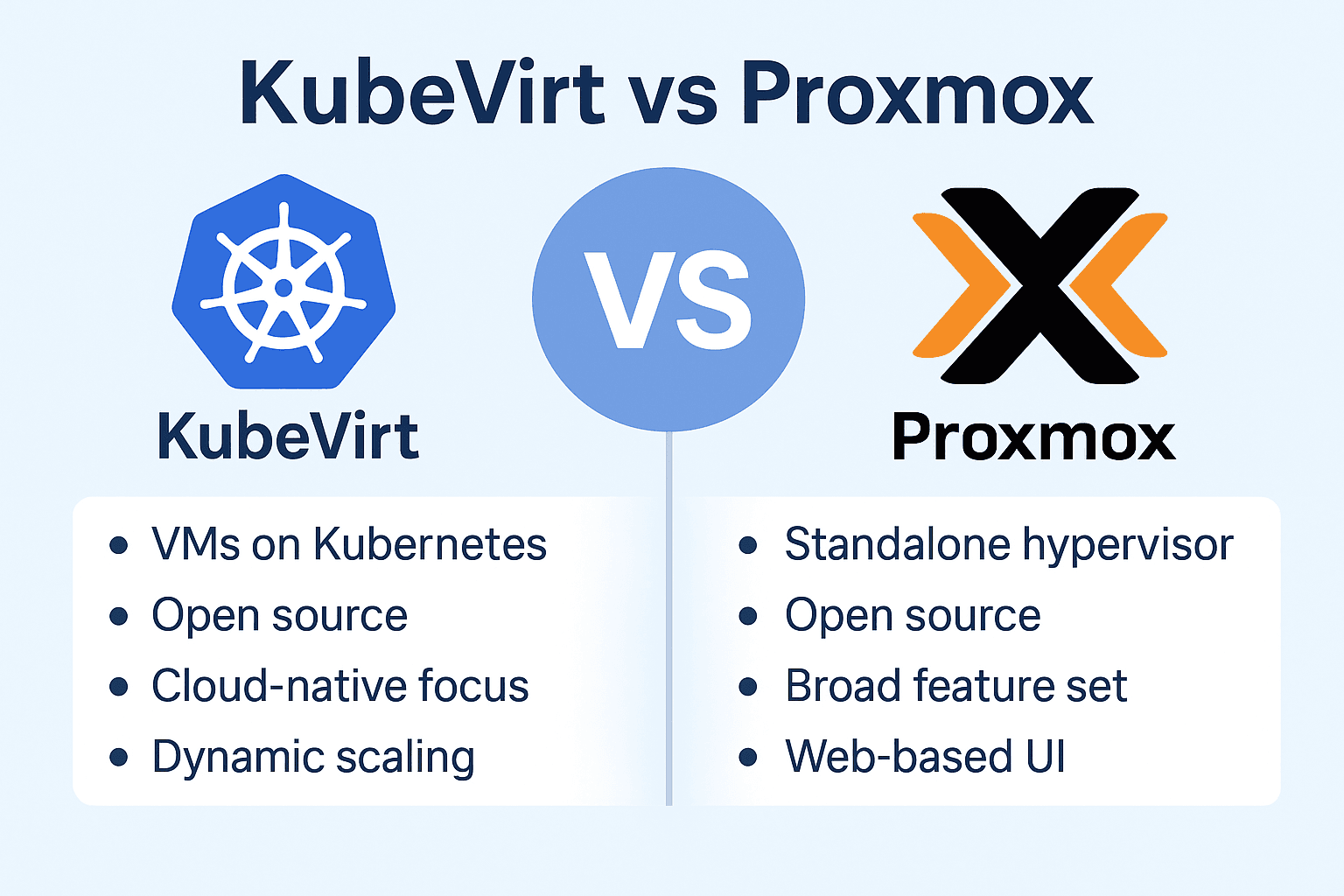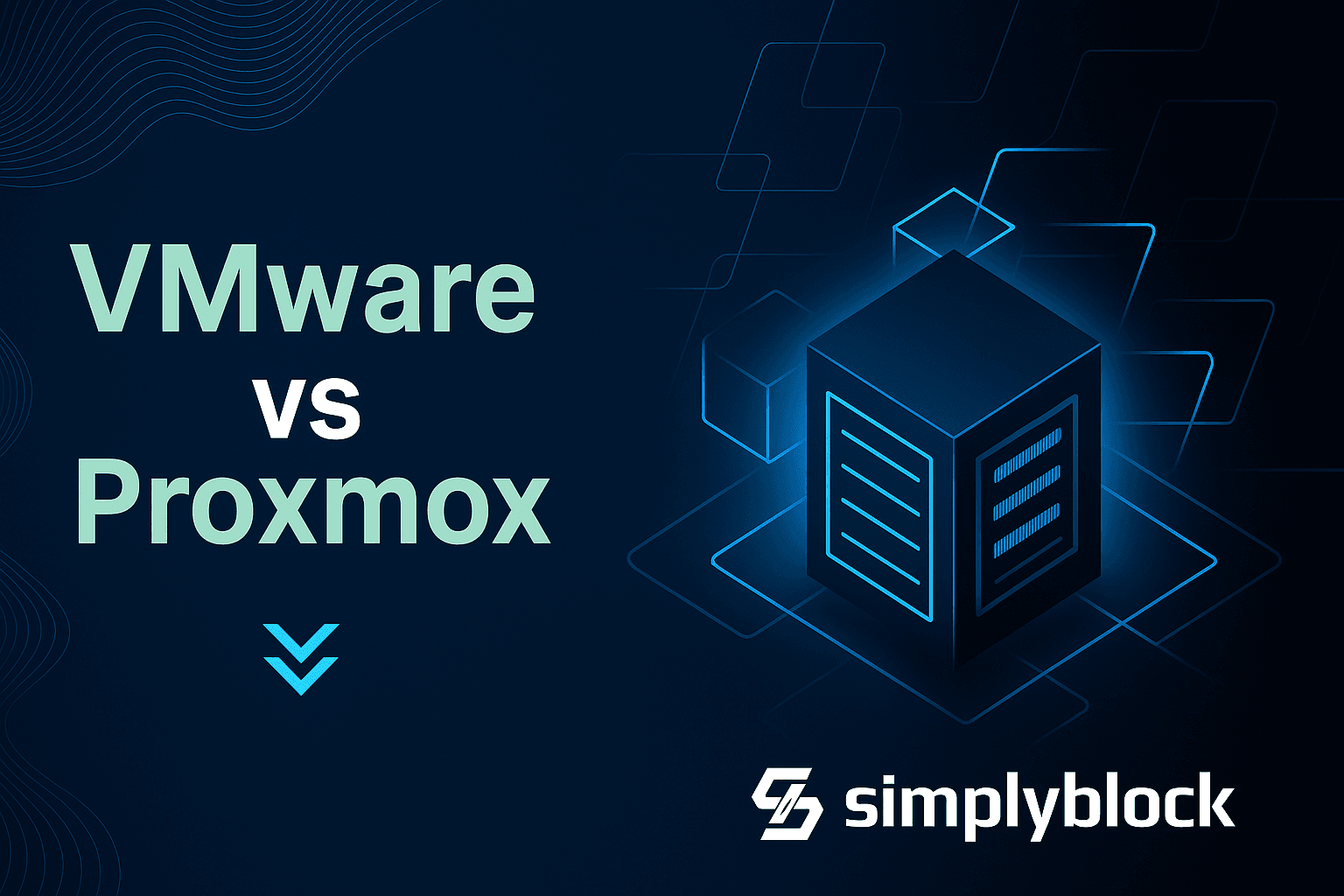
KubeVirt and Proxmox both offer ways to run virtual machines, but they’re designed for very different use cases. Proxmox gives you a flexible, open-source virtualization stack with a familiar UI. KubeVirt, on the other hand, is made for teams that are already working inside Kubernetes and want to manage VM workloads the same way they manage containers.
This guide breaks down the key differences, where each tool works best, and how to choose based on how your infrastructure is evolving.
What is Proxmox VE
Proxmox VE (Virtual Environment) is an open-source platform that combines KVM-based virtualization with LXC containers, all managed through a built-in web interface. It’s widely used in SMBs, home labs, edge environments, and production systems that don’t need the overhead of enterprise tools.
Proxmox includes clustering, live migration, backup capabilities, and support for storage options like ZFS and Ceph, with no external plugins required.
🚀 Fast Disaster Recovery for KubeVirt vs Proxmox Setups
Protect hybrid VM workloads with low-latency backups and multi-zone resilience.
👉 See Simplyblock for Disaster Recovery →
Use Cases for Proxmox
Proxmox is often used in smaller-scale setups that need full virtualization without enterprise complexity. It’s great for self-hosted environments, labs, and teams managing lightweight edge workloads where Kubernetes isn’t already deployed.
It’s also a solid choice for running containers and virtual machines together, especially when Kubernetes isn’t part of the stack yet.
Benefits of Proxmox
- Integrated support for both VMs and LXC containers
- Web-based management and built-in clustering
- Snapshot and backup support without third-party tools
- Works with local, ZFS, NFS, and Ceph storage out of the box
- Transparent, open-source licensing

What is KubeVirt
KubeVirt is a Kubernetes-native way to run virtual machines alongside your containerized workloads. It’s not a replacement for Kubernetes — it extends it, letting you treat VMs just like any other Kubernetes object.
Virtual machines in KubeVirt are defined using custom resources, deployed via kubectl or GitOps, and run inside pods using KVM. That means no new tooling — just Kubernetes.
Use Cases for KubeVirt
KubeVirt fits naturally into modern, container-centric teams that still need to run some VMs. It’s used in CI pipelines that require testing across multiple OS types, as well as for hybrid environments where VM-based and container-based workloads live side-by-side.
It’s also seeing adoption for VDI and legacy workload support in Kubernetes-native platforms like OpenShift and Rancher.
Benefits of KubeVirt
- VM management using familiar Kubernetes tools
- GitOps-friendly with YAML-based VM definitions
- No need for separate virtualization infrastructure
- CSI-compatible storage and full CNI network support
- Bridges traditional VM workloads into Kubernetes
KubeVirt vs Proxmox – Complete Technical Comparison
KubeVirt and Proxmox serve different needs in virtualization, but both offer strong capabilities. The table below outlines their key differences to help you decide.
| Feature | Proxmox VE | KubeVirt |
|---|---|---|
| Virtualization Type | KVM + LXC | KVM (inside Kubernetes pods) |
| Management Interface | Web-based UI | kubectl, YAML, GitOps |
| Cluster Management | Built-in | Inherits Kubernetes cluster management |
| Container Support | LXC (basic) | Native via Kubernetes |
| Backup & Snapshot Tools | Built-in | Kubernetes-native tools + CSI support |
| Automation | Proxmox API, scripts | GitOps, Operators |
| Ideal Use Case | Self-hosted or edge virtualization | Kubernetes-native VMs |
| Licensing | Open-source, optional support | Open-source |
Do They Work Together in Some Setups
Yes — and not just in theory. Proxmox is often deployed in resource-constrained environments like branch offices or local labs, while KubeVirt powers centralized or cloud-native infrastructure. You might see Proxmox used at the edge, with KubeVirt handling container-native services in the data center.
Some teams even use Proxmox as a hypervisor layer beneath Kubernetes clusters, or alongside KubeVirt-based platforms such as OpenShift or Rancher, depending on workload types.
Simplyblock as a Fit for KubeVirt and Proxmox
Whether you’re running virtual machines on Proxmox or managing them through Kubernetes with KubeVirt, Simplyblock delivers fast, reliable block storage for both. It integrates with Proxmox deployments via native iSCSI/NVMe-oF, and with KubeVirt via the Kubernetes CSI interface.
Teams use Simplyblock for disaster recovery across zones, Kubernetes-native snapshots, and scaling persistent storage across hybrid or multi-cloud infrastructure.
What to Consider Before You Decide
Proxmox is ideal when you want simplicity, speed, and full control — especially in smaller environments that don’t rely on Kubernetes. If you’re already operating in Kubernetes or planning to centralize VM and container operations into one platform, KubeVirt is the more seamless option.
Each has its strengths, and when supported by a single, flexible storage layer like Simplyblock, running both is not only possible, it’s practical.
Questions and answers
KubeVirt allows Kubernetes users to manage virtual machines natively alongside containers. It’s ideal for organizations moving toward containerized workflows while maintaining legacy VM-based applications. It works seamlessly with Kubernetes-native CSI storage integration for persistent volumes.
Proxmox VE is a turnkey open-source platform combining KVM/QEMU virtualization and LXC containers, managed through its GUI. Unlike Kubernetes-native KubeVirt, Proxmox offers a traditional hypervisor UI and clustering features. For high-performance block storage on Proxmox, see our Proxmox VE Storage support page.
KubeVirt is ideal for Kubernetes-first environments with mixed workloads, enabling DevOps-style automation for VMs. Proxmox suits teams preferring a full-featured GUI outside Kubernetes. Those integrating hybrid storage for Kubernetes and VMs may benefit more from KubeVirt.
KubeVirt is fully open-source, leveraging Kubernetes’ namespace isolation for multitenancy. Proxmox also avoids licensing fees but requires custom logic for tenant separation. Workloads running on multi-tenant NVMe-backed storage may scale more cleanly with KubeVirt.
KubeVirt supports dynamic scaling through Kubernetes primitives and integrates with CSI storage drivers. Proxmox uses traditional tools like ZFS and Ceph with its own cluster manager. Simplyblock’s support for Kubernetes-native storage over NVMe/TCP aligns more naturally with KubeVirt’s automation approach.



